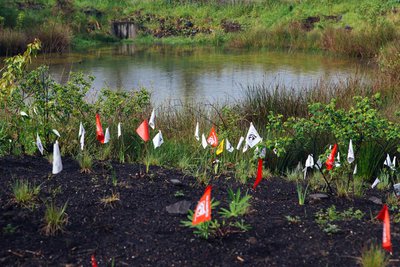
Would you believe there are beavers, otters, herons and a variety of other species living along Amazon Creek in Eugene?
It’s true, thanks to a growing number of local businesses that are becoming certified by the Long Tom Watershed Council’s (LTWC) Trout Friendly Landscapes program. The goal of the program is to make habitat and water quality improvements in private lands that will, in turn, support native aquatic life in Amazon Creek and the Willamette River.
Cutthroat trout in the Willamette have begun to venture into the Long Tom River near Junction City, though the fish don’t make it far because the water quality is too poor to support them. Conservation mascots have a successful record of enticing adults to avoid polluting. Cutthroat trout were chosen as the “sexy” species to attract the attention of the Eugene community. The trout also act as an effective indicator species to gauge the progress of the program.
As Eugene continues to grow and impervious surfaces such as roads and parking lots become more common, water needs a path to travel. As much as 70 percent of stormwater runoff finds its way to Amazon Creek, carrying with it pollutants such as motor oil, pesticides, fertilizers, litter and heavy metals. LTWC finds that many stormwater pollutants are coming from landscapes. This is because the natural hydrologic processes have been altered by replacing earth and plants with hardscapes — those parking lots and roads — leaving “just those little pieces of earth we have poking up through our urban areas,” as Sarah Whitney with LTWC puts it.
As a licensed landscape architect and LTWC’s stormwater specialist, Whitney heads up the Trout Friendly Landscapes initiative. She works closely with a growing number of commercial and industrial businesses like Mountain Rose Herbs, Essex Construction, Thermo Fischer and Joe’s Garage. Whitney walks each business through all the steps in becoming a certified Trout Friendly Landscape from landscape design to permitting and in many cases matching costs through grants and incentives from the city of Eugene.
Clinton Begley, LTWC development and communications director, explains: “Our goal is to go above and beyond the city requirements. Serving human values can also serve habitat functions.” The city of Eugene currently requires that water quality remain at its current level. The current status of Amazon Creek and the Willamette River, however, is impaired.
According to a 2009 article in the Journal of Hydrologic Engineering, the amount of impervious cover in Eugene hinders Amazon Creek as “non-supporting,” meaning it “no longer supports its designated use in terms of hydrology, channel stability, habitat, water quality or biological diversity. Non-supporting streams become so degraded that it may be difficult or impossible to fully recover redevelopment stream function and diversity.”
LTWC has been testing the presence and concentration of pesticides in water and soils along Amazon Creek regularly since 2011. This data is used to trace the contaminants back to their industrial, commercial or residential source. The information is regularly shared with farmers and community members to increase awareness of how specific contaminants adversely affect aquatic life. For example, studies have shown that even trace amounts of zinc can have detrimental effects on salmon and trout, impairing their sense of smell and inhibiting their ability to find food, mate, sense danger and lay eggs. This effectively leads to increased mortality rates.
“We know that moss killers are a major source of zinc,” Whitney says. “We also know that galvanized surfaces are a very high source of zinc, and if you look at an aerial photo you will notice that almost all of the roofs in the industrial sector are galvanized. Stormwater planters are a great way to treat them without taking up a lot of square footage.”
Whitney points out that “the most effective treatment is also the cheapest — to run the water through soil and plants before entering the waterways. That’s what we call Low Impact Development (LID).” Examples of LID stormwater facilities include rain gardens, bioswales, stormwater planters, filter strips and sand filters. Native plants are a key component of these facilities because they filter stormwater and provide wildlife habitat.
“I’ve seen great pictures of bacteria really glomming on to a little piece of zinc, and they’re actually munching on it,” Whitney explains. “Healthy soil biota is where you get pollutant treatment.”
Local commercial and industrial businesses interested in implementing a Trout Friendly Landscape can look to Mountain Rose Herbs as a benchmark. The company uses such practices as conserving water with a satellite controlled irrigation system, maintaining a pesticide-free facility and utilizing bio-swale to naturally filter roof and pavement runoff. They are also the first Eugene business to become certified salmon-safe.
Eugene residents can reduce stormwater contaminants by properly maintaining vehicles, using natural moss control products from local companies such as Glass Tree Care and installing rain gardens or other LID stormwater facilities to slow and filter water before it hits the storm drains.